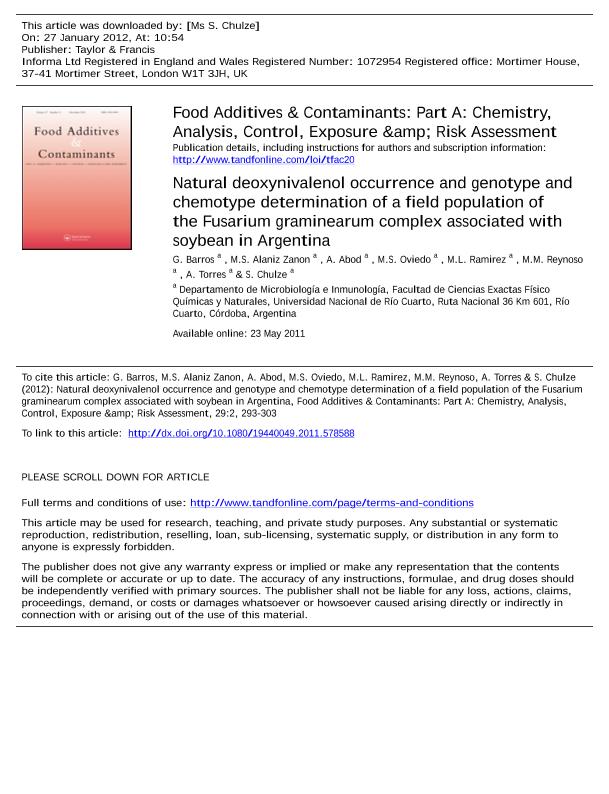Artículo
Natural deoxynivalenol occurrence and genotype and chemotype determination of a field population of the fusarium graminearum complex associated with soybean in Argentina
Barros, G.; Alaniz Zanon, Maria Silvina ; Abod, Ayelen Selene
; Abod, Ayelen Selene ; Oviedo, Maria Silvina
; Oviedo, Maria Silvina ; Ramirez, M. L.; Reynoso, M. M.; Torres, A.; Chulze, Sofia Noemi
; Ramirez, M. L.; Reynoso, M. M.; Torres, A.; Chulze, Sofia Noemi
 ; Abod, Ayelen Selene
; Abod, Ayelen Selene ; Oviedo, Maria Silvina
; Oviedo, Maria Silvina ; Ramirez, M. L.; Reynoso, M. M.; Torres, A.; Chulze, Sofia Noemi
; Ramirez, M. L.; Reynoso, M. M.; Torres, A.; Chulze, Sofia Noemi
Fecha de publicación:
02/2012
Editorial:
Taylor & Francis
Revista:
Food Additives and Contaminants
ISSN:
1464-5122
Idioma:
Inglés
Tipo de recurso:
Artículo publicado
Clasificación temática:
Resumen
Soybean (Glycine max L.), the main source of protein throughout the world, is used both as a food and a feedstuff. Currently, limited information about the occurrence of Fusarium species and mycotoxins in soybean grain and by-products is available. The aims of the present study were: (1) to identify toxigenic Fusarium species associated with soybean during crop reproductive stages; (2) to determine the occurrence of deoxynivalenol (DON) and nivalenol (NIV) in soybean seeds; (3) to determine the genotype and chemotype of selected Fg complex strains using molecular and chemical analysis, respectively; and (4) to characterize the strains using AFLPs markers. One soybean field located at Córdoba Province, Argentina, was monitored and samples of soybean tissue were harvested at three reproductive stages: flowering (R2), full seed (R6) and full maturity (R8). A total of 389 Fusarium strains F. equiseti (40%) was the most frequently species recovered followed by F. semitectum (27%) and F. graminearum (Fg) (11%). From the 40 soybean samples analysed, only two presented detectable DON levels. Based on DON occurrence on soybean seeds at ripening stages, the toxigenic ability of Fg complex strains isolated from soybean seeds, pods and flowers were analysed. The trichothecene genotype was determined by a multiplex PCR using primers based on Tri3, Tri5 and Tri7 toxin genes and then the chemotype was verified by chemical analysis. Most Fg complex strains showed 15-ADON genotype and five strains presented a DON/NIV; these also produced both toxins under in vitro culture. Neither the NIV nor the 3-ADON genotypes were detected among the members of the population evaluated. All the 15-ADON genotype strains were characterized as F. graminearum sensu stricto (lineage 7), while the strains presented a DON/NIV genotype were characterized as F. meridionale (lineage 2). The present study contributes new information on the occurrence of Fusarium species and trichothecenes toxins on soybean at the pre-harvest stages. Also, this is the first report on the chemotype, genotype and lineages among Fg complex isolated from soybean.
Palabras clave:
BEANS
,
FUNGI
,
MOLECULAR BIOLOGY
,
MYCOLOGY
,
MYCOTOXINS
,
PCR
,
TRICHOTHECENES
Archivos asociados
Licencia
Identificadores
Colecciones
Articulos(CCT - CORDOBA)
Articulos de CTRO.CIENTIFICO TECNOL.CONICET - CORDOBA
Articulos de CTRO.CIENTIFICO TECNOL.CONICET - CORDOBA
Citación
Barros, G.; Alaniz Zanon, Maria Silvina; Abod, Ayelen Selene; Oviedo, Maria Silvina; Ramirez, M. L.; et al.; Natural deoxynivalenol occurrence and genotype and chemotype determination of a field population of the fusarium graminearum complex associated with soybean in Argentina; Taylor & Francis; Food Additives and Contaminants; 29; 2; 2-2012; 293-303
Compartir
Altmétricas



